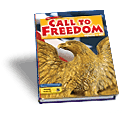Monticello Middle School
Mr. Stephens
|
Chapter 3
New Empires in the Americas (1500–1700) September 23- October 7 Overview . . . . By 1500, Europeans had begun crossing the Atlantic Ocean in search of wealth, glory, and converts to the Christian faith. Spain established a large colonial empire in North and South America. The Spanish were soon followed by explorers seeking to establish colonies for other European nations . . . During the Reconquista there was constant warfare in Spain, creating a class of Spanish warriors that had little land or money. After the Reconquista these soldiers lacked work. Military leader Hernán Cortés explained the problem. “Since this harsh land will yield us no living, we must rely on our swords and lances. For the same reason, we must move on.” In the 1500s many Spanish soldiers chose to “move on” to the Americas to seek their fortunes.
Conquistadores such as Hernán Cortés and Francisco Pizarro conquered a huge territory for Spain. By the mid-1500s Spain’s American empire was larger than that of any other European nation. However, the challenge for Spain had changed. A Spanish official described the problem. “Without settlement there is no good conquest.” Spain had to somehow settle and control an empire many times its size from across the ocean. On October 31, 1517, a priest named Martin Luther nailed an important paper to the door of Castle Church in Wittenberg, Germany. The paper listed 95 theses about theCatholic Church. Luther charged that the church was too wealthy. He also thought the church abused its power. Charles V, emperor of the Holy Roman Empire, asked Luther to give up his views. Luther replied, “I cannot and will not.” He added, “On this I take my stand. I can do no other.” When French explorer Jacques Cartier sailed to North America
in 1534, he witnessed many strange sights. He saw walruses and
thousands of seabirds. He said these birds covered islands “as a field
is covered with grass.” However, one of the most unexpected sights was
a French fishing boat! French fishermen had begun traveling to the
north coast of North America in the early 1500s. Cartier soon saw why.
There were so many fish that he and his crew could catch about 100 cod
in an hour. Some of the fishermen had built temporary settlements to
trade with local American Indians.
English Settlements
In the late 1500s England decided to start its own North American colony. In 1578 Sir Humphrey Gilbert received a patent, or charter, a document giving him royal permission to start a colony. Gilbert sent an expedition to Newfoundland, which England claimed as a result of John Cabot’s explorations. Gilbert’s efforts to found a colony failed, and he drowned at sea in 1583. His half-brother, Sir Walter Raleigh, soon led a new effort. Raleigh paid for an expedition that landed in
present-day
Virginia
and North Carolina. He named the entire area Virginia. In 1585 he sent
another group to found a colony on Roanoke
Island. The English
colonists found life hard. They fought with local American Indians and
had trouble finding and growing food. In 1586 Sir Francis Drake stopped
at Roanoke after a raid on New Spain. He offered to take the remaining
settlers home to England.
John White
resettled the Roanoke colony in the spring of 1587.
White’s granddaughter, Virginia Dare,
was the first English child born
in the present-day United States. White returned to England at the end
of the summer and did not come back until 1590. He found the colony’s
buildings still standing but deserted. Carved into a post was the word CROATOAN.
This may have been the name of a nearby island inhabited by American
Indians. White searched for the settlers and his granddaughter. Years
later he recalled his efforts. “And thus we [stopped] seeking our
Colony, that was never any of them found, nor seen to this day.”
Historians are not certain just what happened to the colony.
 Reading Check:
Summarizing Explain the reasons for and the results
of
England’s first attempts to colonize North America. Reading Check:
Summarizing Explain the reasons for and the results
of
England’s first attempts to colonize North America. |
| Assignments The following requirements must be completed. How they are fulfilled is your choice. The methods you choose must be pre-approved. "Old School" Using the Cornell Note-taking method, download Cornell Template Please complete each Review Section in the textbook as instructed below
|
|
| Section 1 The Conquistadores
|
Section 2 Spanish America
|
| Section 3 Religious and Political Changes in Europe
|
Section 4 The Race for Empires
|
|
|
|
|
Possible Alternative Assessments
Each topic question may be used as one alternative assessment
|
|
|
Chapter 3 |
|
What's on the test? |
|
|
